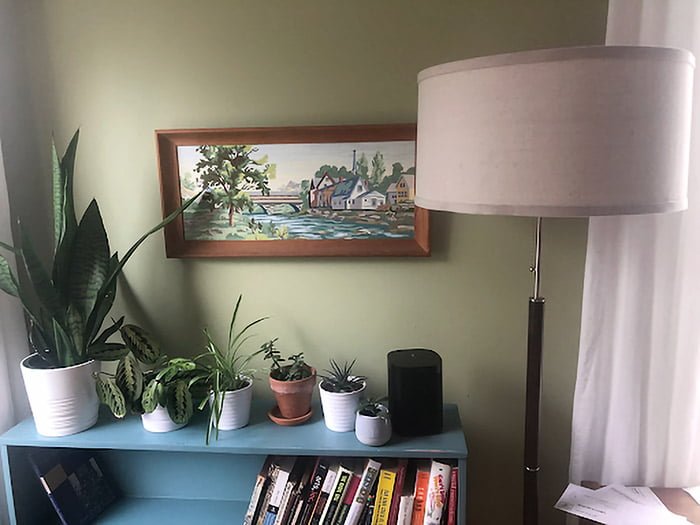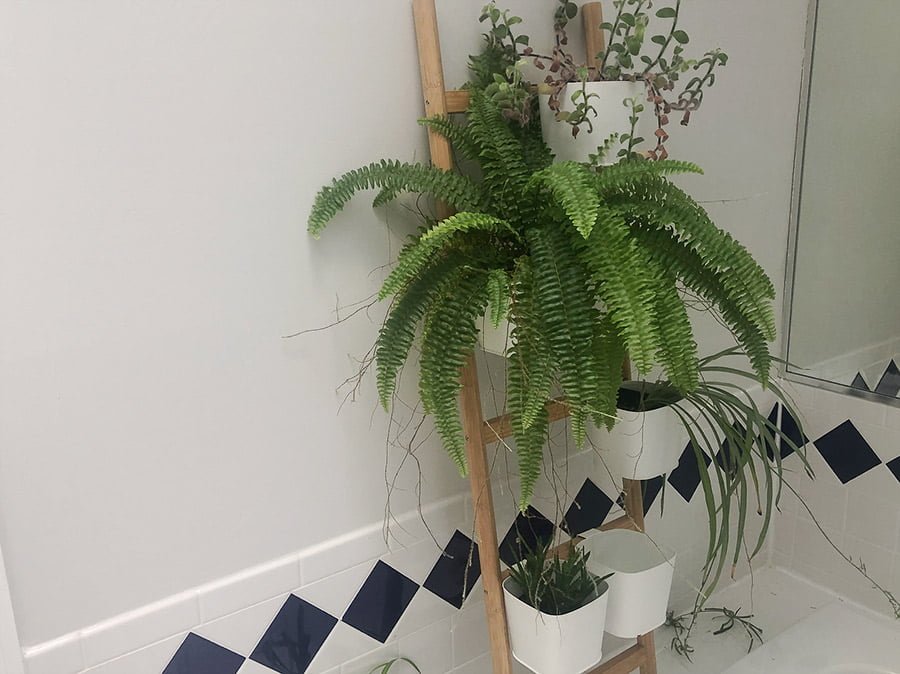One of the best things about getting a diagnosis at age 38, was learning that a lot of the sensory sensitivities I had experienced over the years had explanations. Light, color, sound, and visual clutter that bothered me didn’t necessarily bother other people, and sometimes this led to confusion and conflict, particularly with people I shared living or workspace with. People sometimes misinterpreted my sensory needs as arbitrary taste preferences, or acted as though I was being overdramatic about something minor that was annoying me. This kind of gaslighting about sensory environments—even when unintentional—has been a source of pain since childhood.
At the same time, these sensitivities offered access to creative tools. Over time, I learned that I could make living spaces more comfortable and beautiful—for everyone!—by noticing details and making small changes that other people wouldn’t have thought about. Maybe other people are less bothered by the stressful flickering lights or noisy dishwasher than you, but they still benefit when you notice the problem and fix it.
Unfortunately, most resources for design and autism are targeted either toward parents of autistic children, or for designers/builders of facilities and group homes; autistic adults are thus stuck relying on trial and error and intuition to create environments in which they can thrive.
Optimizing my sensory environment to help me feel calm, in control, and productive has been an important part of embracing my super powers and taming my kryptonite. And this optimization isn’t just about eliminating sensory problems that annoy: it’s making proactive positive choices that comfort and soothe, to give you the best shot at being your best self. Here’s some of what I’ve learned—this is by no means comprehensive, but I hope it will encourage more of us to document what’s working for us.
Big picture principle: Trust your instincts and try things out.
Obviously, no two autistic people are the same, and what makes one person feel extremely comfortable can be profoundly stressful to someone else. Maybe the colors that help me feel blissfully calm will make you feel moody and depressed? You’re going to be the best judge of what works for you, but it may take some trial and error.
That means you probably should try things out before making big expensive changes to your environment. Try replacing a couple of lightbulbs to see if you like them before changing all the lightbulbs in your house, or try a sample jar of paint before buying a full gallon and repainting a room.
Color & finish
When I moved into my home, it was painted throughout in an orange–beige color that I hated; I called it “stressful peach.”
I loved my home, but I always felt on edge for reasons I couldn’t quite name, and over time I realized it was the color. Before my diagnosis, my spouse struggled to understand why changing the paint color was such an important priority for me, but when I went ahead and painted a couple of rooms in colors that I intuitively felt would be calming, it was like I could finally exhale and feel at peace.

After my diagnosis, I learned that research has actually demonstrated that autistic people really do better with certain paint colors, and the shades that I intuitively chose were in the color family that experts recommended: subdued colors, colors with some grey in them, with an emphasis on the green–blue part of the color spectrum. More research needs to be done but GA Architects, a firm that specializes in designing for autistic people recommends these colors:[1]Colour and best practice in autism design | ISSUU

In short, my autistic brain was telling me what I needed; I just had to trust it.
Paint
A fresh coat of paint is perhaps the most inexpensive way to transform a space. Start by choosing low arousal colors—that means no bright primary colors. Bold deep hues can be okay in spaces that have a specific use—a bolder saturated indigo might be okay for a dining room, but not if it doubles as your office. Grey-green-blue is a good place to start. I tend to like cool colors with just a hint of warm undertones, and when warm colors are used, I make sure there are cool undertones to balance them out. Red in particular should be avoided. I used Behr’s “Back To Nature” for my home office—it’s a calming, muted green, a cool color with hints of warmth.
Neutrals are also often a good choice. I tend to like cool neutrals with a hint of warm undertones, and warm neutrals with cool undertones. In my home, I chose Behr’s Toasty Gray which is a light warm gray with cool green undertones. For the bathroom I went one step lighter, with Behr’s Campfire Ash. I finally feel relaxed during my morning and evening routines—it’s a huge improvement over the pale yellow that came before.
Wood tones
Wood tones for floors and furniture tend to be warm, and can benefit from cool stain to mellow them out. Once again, getting some gray in there helps. I like midtone stains with some gray to help bring some calm. For example, I like Minwax’s “rustic beige” or “silvered grey.” Avoid anything with too much orange or gold. I also like to avoid floors that are too dark—it feels too heavy and stressful.
Furnishings
For soft furnishings, similarly simple solids in similar color families are a good plan. Patterned rugs are best if the pattern is lower contrast, rather than bold stripes. Generally reducing contrast can be helpful. Personally, I don’t mind white furniture—but a charcoal grey is less stressful than black. I also tend to prefer matte or satin finishes on furniture over gloss, because of the potential for glare (more on glare in the light section).
Bringing nature indoors
Some studies have shown that time with nature is really helpful for reducing stress. I’ve found bringing natural elements into living spaces is really helpful for me. Low maintenance houseplants contribute cool, calming green tones to spaces.

I also have found that tables made of old locust, and even this branch I hung in my kitchen helps me feel calm and grounded.

Light
Natural light
Maximizing natural light is generally a good thing, especially if you have window treatments that allow you to modulate the light as necessary. In my bedroom, I have roller blinds to block light completely, and soft linen curtains (both inexpensive, from IKEA) to filter light when necessary.
The direction of the light will also potentially impact the paint colors you want to choose. Afternoon light (from the South/East) tends to be warmer; I found using cooler tones in rooms exposed to the afternoon Sun can help me feel calm. For example, I just repainted this guest room in a pale muted blue with grey/violet undertones (Behr’s Light Drizzle), and now I’m much calmer there in the afternoon.
Artificial light
Fixtures
Minimizing glare is important. I tend to like more light sources, at lower levels rather than fewer brighter lights—it results in more even lighting and less glare. A blend of overhead light, accent lighting, and task lighting is best, as it helps give a space a calming glow. Adding a table lamp and floor lamp and making the ceiling bulb less bright is a good step toward a more comfortable space.
Picking the right light bulbs can make a huge impact on some peoples’ mood and productivity. There are three numbers to look for: CRI, color temperature, and lumens.
CRI
The color rendering index (CRI) is an indicator of how accurate the light is at reproducing the full spectrum of light. This is often overlooked in picking lightbulbs and I find it can be the biggest factor in whether a room feels comfortable to me.
I only use lightbulbs rated at 90+ CRI. Higher is better if I can find it! This is particularly true in office spaces with fluorescent bulbs—which can be among the lowest CRI. My old office became instantly more comfortable when I replaced old 75 CRI fluorescent bulbs with 90 CRI.
Color temperature
The color temperature denotes how cool or warm the light appears, expressed in Kelvin and ranging from 2500–8000K. 2700K is what usually gets called “warm white”, a yellowish tone; whereas 5000K is often labeled “daylight”, which can feel blueish.
I tend to use 3000K bulbs in living spaces, 3500K for offices, and 4000K for environments like laundry rooms or windowless bathrooms. Lower temperatures (like the common 2700K warm white) make me feel sluggish and moody, and higher temperatures (like 5000k or “daylight”) make it hard for me to relax. But your experience may vary.
Lumens
Lumens is a measure of brightness. In places where bulbs are bare, it’s best to go for a lower lumens bulb. I have this lamp in my living room, and use a weak 400 lumens bulb, and even then I have it on a dimmer.
Dimmers
Personally, I find that I’m often the most comfortable with slightly lower light than most people gravitate towards but more light sources around the room.
An unfortunate side effect of dimmers is that they sometimes hum or buzz, particularly if you are using cheaper bulbs or cheaper dimmers. I find that Lutron’s Caseta series works well for me, though it depends on the bulb. But again, before you install a bunch of dimmer switches try installing one and see if you can deal with any sound that it makes.
A nice thing about smart lightbulb systems is that you can set lighting presets automatically for different times of day—this can help trigger routines for you.
Sound
It’s no secret that autistic people can be more attuned to environmental sounds, from housemates, officemates, etc. When folks talk about “soundproofing” they often confuse two distinct concepts, and this leads them to be disappointed when they try to make changes:
Sound transmission
This is about outside sound getting into a space, like the leafblowers annoying me from across the street. Addressing this usually can only be done at the level of construction: getting insulation into interior walls, choosing double or triple-paned windows, extra layers of drywall, subfloor insulation, etc.
Sound absorption
This is easier to control—it’s about what happens to sound once it’s in a space. In a space with lots of hard surfaces, sound bounces around which can contribute to sensory overwhelm. Adding absorbent surfaces can help mellow things out, but it won’t stop sound from getting in.
And of course, there’s a third factor:
Sound generation
Different appliances etc. generate noise, and choosing quieter dishwashers, refrigerators, washers, dryers, etc can make a big difference. New appliances can be expensive, but exhaust fans for baths and kitchens are especially inexpensive to replace with quieter fans! Look for the decibel rating and buy the quietest fan that fits your needs.
Solid core doors
This is one easy thing that you can do to decrease sound transmission between rooms. Many homes are outfitted with cheap hollow core doors, and you might be annoyed by speech or other sounds from housemates. A solid core door can make a meaningful difference. It may also be worth filling the gap between the jamb and the frame (it’s usually covered by the trim) with some foam insulation. To compare doors look for the “STC” rating, which stands for “sound transmission class”; a higher number is better. Also, do your best to minimize gaps at the bottom of doors at installation.
Acoustic panels
Some rooms can be echoey and this can contribute to overstimulation. It can also make it more challenging to comprehend speech, particularly if you’re on zoom calls and working from home like so many of us right now. You may be partially able to remedy this with upholstered furniture and thick rugs, but if that’s not enough, buying or building some sound-absorbing panels may also be a good move. In my office, I have these simple panels built with wood, some Owens Corning 703 acoustic insulation panels (also called rigid fiberglass), and covered in fabric.
Storage
Home organization is a whole separate topic from design, and entire books can and probably will need to be written about how to organize autistic people’s homes. One thing I can confidently recommend:
Get enough storage for all of your stuff
Because of our strong impulses toward systematization, we often can be good at devising ways to organize things, if not always good at implementation. Simply having enough shelves/drawers etc for all your books (or DVDs, or LPs, or action figures or ceramic koalas or whatever) can be potentially life-changing in the sense of calm and control it allows.
Because a lot of autistic people also have ADHD, people try to give us organizing or design strategies that might work well for ADHD, like keeping all your stuff visible for ease of retrieval. Personally, I found that this has the opposite effect; when everything is visible, I tend to be easily distracted and overstimulated. I find storage that hides stuff (with a cabinet front or drawer) when I’m not using it to be most calming. For my record collection, I hung these curtains to hide them when I’m not looking for a particular album. (It also protects them from sunlight.). Trust your instincts and try things out!
Movement
Autistic people are prone to a kind of low-level claustrophobia that robs us of some spoons every day if we don’t structure the environment to avoid it. I find that I do best when movement pathways between rooms are unobstructed. That means: never store things on the floor, if possible! Keep chairs and other furnishings away from doorways and passageways. Less furniture can be better than more.

The picture above illustrates 3 problems: not enough storage, stuff that’s visually exposed and looks cluttered, and an object too close to a movement pathway between rooms! Every time I walk past this I feel like hitting myself in the head with a hammer. Those CDs belong in some storage drawers!
Have fun!
Try and embrace the fun of making your environment comfortable, rather than focusing on the annoyance of sensory pain. Enjoy learning about colors and light. You may find this all becomes a special interest for a while and you spend hours comparing paint chips and looking at Pinterest all day. Enjoy the process and share what you learn!
Comments
Let us know what you think!